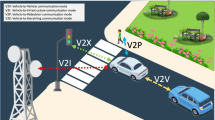Abstract
In this paper, we propose a neighbor stability-based VANET clustering (NSVC) that can efficiently deliver data in urban vehicular environments. The salient features of urban vehicles are their high mobility and unpredictable direction of movement, so vehicle-to-vehicle and vehicle-to-infrastructure (V2X) communication should take into consideration the frequent changes in the topology of vehicular ad hoc networks (VANETs). These technical challenges are addressed with NSVC by including a neighbor stability-based VANET clustering scheme and the corresponding supplementary transmission scheduling method. Thereby, NSVC supports fast cluster formation, minimizes the number of cluster head elections, and moreover guarantees the reliable delivery of data for emergency messages. The results of the simulation indicate that NSVC achieves better network performance when compared to existing approaches.
















Similar content being viewed by others
References
Jayavardhana G, Rajkumar B, Slaven M, Marimuthu P (2013) Internet of Things (IoT): a vision, architectural elements, and future directions. Future Gener Comp Sy 29(7):1645–1660. doi:10.1016/j.future.2013.01.010
Kim EJ, Youm S (2013) Machine-to-machine platform architecture for horizontal service integration. EURASIP J Wirel Commun 2013(1):1–9. doi:10.1186/1687-1499-2013-79
Atzori L, Iera A, Morabito G (2010) The Internet of things: a survey. Comput Netw 54(15):2787–2805. doi:10.1016/j.comnet.2010.05.010
Task Group P (2009) IEEE draft amendment to standard for information technology—telecommunications and information exchange between systems—local and metropolitan networks—specific requirements—part 11: Wireless LAN medium access control (MAC) and physical layer (PHY) specifications: Amendment: Wireless access in vehicular environments. IEEE 802.11p Draft 9.0
Uzcategui R, Acosta-Marum G (2009) WAVE: a tutorial. IEEE Commun Mag 47(5):126–133. doi:10.1109/MCOM.2009.4939288
Xu Q, Mak T, Ko J, Sengupta R (2004) Vehicle-to-vehicle safety messaging in DSRC. In: Proceedings of 1st ACM international workshop on Vehicular ad hoc networks, pp 19–28. doi:10.1145/1023875.1023879
Bai F, Stancil DD, Krishnan H (2010) Toward understanding characteristics of dedicated short range communications (DSRC) from a perspective of vehicular network engineers. In: Proceedings of 16th annual international conference on mobile computing and networking, pp 329–340. doi:10.1145/1859995.1860033
Lee D, Chang SW, Lee SS (2015) Analysis and design on efficient message relay methods in VANET. Multimed Tools Appl 74(16):6331–6340. doi:10.1007/s11042-014-2107-y
Vinel A (2012) 3GPP LTE versus IEEE 802.11 p/WAVE: which technology is able to support cooperative vehicular safety applications? IEEE Wirel Commun Lett 1(2):125–128. doi:10.1109/WCL.2012.022012.120073
Jarupan B, Ekici E (2009) Location-and delay-aware cross-layer communication in V2I multihop vehicular networks. IEEE Commun Mag 47(11):112–118. doi:10.1109/MCOM.2009.5307474
Lin CR, Gerla M (1997) Adaptive clustering for mobile wireless networks. IEEE J Sel Area Commun 15(7):1265–1275. doi:10.1109/49.622910
Basu P, Khan N, Little, TD (2001) A mobility based metric for clustering in mobile ad hoc networks. In: Proceedings of international conference on computing systems workshop, pp 413–418. doi:10.1109/CDCS.2001.918738
Li W (2011) Network clustering in vehicular communication networks. Dissertation, University of Toronto
Hamid RA, Reza EA, Abolfazl D, Atefe P (2015) A cluster-based vehicular cloud architecture with learning-based resource management. J Supercomput 71(4):1401–1426. doi:10.1007/s11227-014-1370-z
Kwon JH, Kim EJ (2015) Adaptive multi-channel allocation for vehicular infrastructure mesh systems. Multimed Tools Appl 74(5):1593–1609. doi:10.1007/s11042-013-1752-x
Omar HA, Zhuang W, Li L (2013) VeMAC: A TDMA-based MAC protocol for reliable broadcast in VANETs. IEEE T Mobile Comput 12(9):1724–1736. doi:10.1109/TMC.2012.142
Singh JP, Bali RS (2015) A hybrid backbone based clustering algorithm for vehicular ad-hoc networks. Procedia Comput Sci 46:1005–1013. doi:10.1016/j.procs.2015.01.011
Kwon JH, Kwon C, Kim EJ (2015) Neighbor mobility-based clustering scheme for vehicular ad hoc networks. In: Proceedings of international conference on PlatCon-15, pp 31–32. doi:10.1109/PlatCon.2015.19
(2003) IEEE Standard for information technology—telecommunications and information exchange between systems—local and metropolitan area networks—specific requirements—Part 11: Wireless LAN medium access control (MAC) and physical layer (PHY) specifications. doi:10.1109/IEEESTD.2003.95617
Yoo J (2015) Receiver-centric physical carrier sensing for vehicular ad hoc networks. Multimed Tools Appl 74(7):2405–2415. doi:10.1007/s11042-014-1851-3
Kim EJ, In J, Youm S, Kang CH (2012) Delay attack-resilient clock synchronization for wireless sensor networks. IEICE Trans Inf 95(1):188–191. doi:10.1587/transinf.E95.D.188
ETSI TR 102 861 V1.1.1 (2012) Intelligent Transport Systems (ITS); STDMA recommended parameters and settings for cooperative ITS; access layer part
ETSI TR 102 862 V1.1.1 (2011) Intelligent Transport Systems (ITS); Performance Evaluation of Self-Organizing TDMA as Medium Access Control Method Applied to ITS; Access Layer Part
Tsai MF, Wang PC, Shieh CK, Hwang WS, Chilamkurti N, Rho S, Lee YS (2015) Improving positioning accuracy for VANET in real city environments. J Supercomput 71(6):1975–1995. doi:10.1007/s11227-014-1215-9
Chu IC, Chen PY, Chen WT (2012) An IEEE 802.11p Based distributed channel assignment scheme considering emergency message dissemination. In: Proceedings of vehicular technology conference, pp 1–5. doi:10.1109/VETECS.2012.6240201
Acknowledgments
This research was supported in part by Basic Science Research Program through the National Research Foundation of Korea (NRF) funded by the Ministry of Education (NRF-2014R1A1A2057641), by the ICT R&D program of MSIP/IITP [B0101-14-0059, Human Resource Development Program for Future Internet], and by the MSIP (Ministry of Science, ICT and Future Planning), Korea, under the ITRC (Information Technology Research Center) support program (IITP-2015-R0992-15-1006) supervised by the IITP (Institute for Information & communications Technology Promotion).
Author information
Authors and Affiliations
Corresponding author
Rights and permissions
About this article
Cite this article
Kwon, JH., Chang, H.S., Shon, T. et al. Neighbor stability-based VANET clustering for urban vehicular environments. J Supercomput 72, 161–176 (2016). https://doi.org/10.1007/s11227-015-1517-6
Published:
Issue Date:
DOI: https://doi.org/10.1007/s11227-015-1517-6




